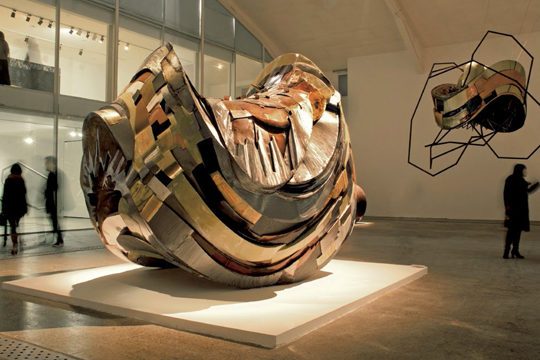WANG YUYANG: LINER
| July 31, 2013 | Post In LEAP 21

In the 1830s, the electric telegraph was invented. It was designed to organize English characters and punctuation according to the frequency with which they occur in text, and then establish a set of rules. Combinations of dots and dashes were used to represent each letter or sign, those occurring most frequently possessing the shortest assignments. When transferred electrically, a dot would correspond to a short electrical pulse, and a dash to a longer one. The telegraph was thus able to effectively and precisely transmit code-bearing information—the computer, invented over a century later, also adopted binary code as the carrier of its data.
Like the technological inventions above, Wang Yuyang, in his new solo exhibition “Liner,” uses technology (3D modeling software) to turn binary code into information (visual images). His process, however, produces none of the intended effectiveness or precision. The appearance of the installation and painting on the right-hand side of the gallery was determined by phrases that Wang Yuyang collected and later transferred to binary code—a string of 1s and 0s that he then imported into image and 3D modeling software such as 3D Max and Painter. The forms, colors, dimensions, and materials automatically generated by the software were then created with actual materials.
The texts “processed” come from a broad range of categories: philosophy (Zhuangzi), religion, literature (Andrew Marvell’s The Definition Of Love), politics (Martin Luther King, Jr’s speech “I Have a Dream”), psychology, and in one section, even, advertising.
If Wang Yuyang purposefully employed the same methods towards a heterogeneous collection of texts to demonstrate the “smooth and neutral” functioning of modern information technology, or if this technology possesses in its cold functioning a crude opposition to knowledge or wisdom, then the works on show on the left-hand side of Tang Contemporary point to a further deepening of humanity’s internalization of technology. The process of their manufacture was no different from that of the pieces by the entrance, except that the code processed did not originate in any text, but simply consisted of a series of 1s and 0s selected randomly by the artist. In this case, in other words, the artist himself became a machine, generating code completely devoid of
meaning.
The two sets of works on display couldn’t appear more different: those which possess “content”—processed text—appear bulkier, feature complex arrangements of materials, and in their dim, unlit surroundings, give off a dull metallic shine. The others, meanwhile, sit under by artificial light, their luster thus brighter and more elegant, their forms more slender and frail.
But even if the audience is able to perceive certain differences between these without further inquiry, that which their eyes behold merely appears to be a set of “modern,” “abstract” sculptures and paintings. Wang Yuyang has given very careful attention to detail here. In aspects such as brushwork and materials selected, Wang applies his own aesthetic tastes (for example, the 3D Max software will have stipulated the material to be “wood,” yet the artist himself remained free to choose between oakwood, elmwood, and so on). Perhaps it is indeed due to this meticulousness that each work’s concept seems so tightly wrapped up by the results of computer-generated images.
In the end, though, Wang Yuyang, a new media artist, presents a series of sculptures and paintings—two “substantive,” and very traditional, mediums. Given that new media has been relegated a mere “behind-the-scenes” role in the art production process, might this be a reaction to the lukewarm reception new media art has received in the gallery system?


